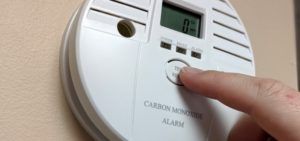
A closed door may slow the spread of smoke, heat, and fire. Install smoke alarms in every sleeping room and outside each separate sleeping area. Install alarms on every level of the home.
Smoke alarms should be interconnected. When one sounds, they all sound.
Large homes may need extra smoke detector installations.
Test your smoke alarms at least once a month. Press the test button to be sure the alarm is working.
Today’s smoke alarms will be more technologically advanced to respond to a multitude of fire conditions, yet mitigate false alarms.
When a smoke alarm sounds, get outside and stay outside.

Although the popularity of carbon monoxide (CO) alarms has been growing in recent years, it cannot be assumed that everyone is familiar with the hazards of carbon monoxide poisoning in the home.

CO alarms should be installed in a central location outside each sleeping area and on every level of the home and in other locations where required by applicable laws, codes or standards. For the best protection, interconnect all CO alarms throughout the home. When one sounds, they all sound.
Follow the manufacturer’s instructions for placement and mounting height.
Choose a CO alarm that has the label of a recognized testing laboratory.
Call your local fire department’s non-emergency number to find out what number to call if the CO alarm sounds.
Test CO alarms at least once a month; replace them according to the manufacturer’s instructions.
If the audible trouble signal sounds, check for low batteries. If the battery is low, replace it. If it still sounds, call the fire department.
If the CO alarm sounds, immediately move to a fresh air location outdoors or by an open window or door. Make sure everyone inside the home is accounted for. Call for help from a fresh air location and stay there until emergency personnel.
If you need to warm a vehicle, remove it from the garage immediately after starting it. Do not run a vehicle or other fueled engine or motor indoors, even if garage doors are open. Make sure the exhaust pipe of a running vehicle is not covered with snow.
During and after a snowstorm, make sure vents for the dryer, furnace, stove, and fireplace are clear of snow build-up.
A generator should be used in a well-ventilated location outdoors away from windows, doors and vent openings.
Gas or charcoal grills can produce CO — only use outside.
CO enters the body through breathing. CO poisoning can be confused with flu symptoms, food poisoning, and other illnesses. Some symptoms include shortness of breath, nausea, dizziness, lightheadedness, or headaches. High levels of CO can be fatal, causing death within minutes.
The concentration of CO, measured in parts per million (ppm), is a determining factor in the symptoms for an average, healthy adult.
50 ppm: No adverse effects with 8 hours of exposure.
200 ppm: Mild headache after 2–3 hours of exposure.
400 ppm: Headache and nausea after 1–2 hours of exposure.
800 ppm: Headache, nausea, and dizziness after 45 minutes; collapse and unconsciousness after 1 hour of exposure.
1,000 ppm: Loss of consciousness after 1 hour of exposure.
1,600 ppm: Headache, nausea, and dizziness after 20 minutes of exposure.
3,200 ppm: Headache, nausea, and dizziness after 5–10 minutes; collapse and unconsciousness after 30 minutes of exposure.
6,400 ppm: Headache and dizziness after 1–2 minutes; unconsciousness and danger of death after 10–15 minutes of exposure.
12,800 ppm: Immediate physiological effects, unconsciousness and danger of death after 1–3 minutes of exposure.
Smoke alarms save lives. Proper smoke detector installation and maintenance play a vital role in reducing fire deaths and injuries. If there is a fire in your home, smoke spreads fast and you need smoke alarms to give you time to get out.